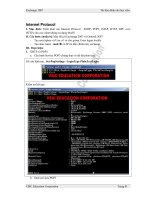Tài liệu Managing Density ppt
Bạn đang xem bản rút gọn của tài liệu. Xem và tải ngay bản đầy đủ của tài liệu tại đây (277.77 KB, 8 trang )
Managing Density
Managing Density in the Data Center:
A Long-term Approach for the Future
Increasing capacity and network applications create new challenges for both the
planners who design and the operations personnel who maintain the network.
A managed density approach that takes a long-term view of data center design
is key to ensuring maximum density and growth without disrupting operations
that can cause a huge drain on productivity, profits, and service availability.
Successful network managers should always take into account the importance
of planning and maintaining data centers to maximize density and minimize
maintenance hassles.
This paper discusses the five key elements of maintaining managed density
in the data center:
Planning•
Installation•
Cable Management •
Accessibility•
Reliability•
Managing Density in the Data Center: A Long-term Approach for the Future
Page 2
Planning
The planning process within your data center is crucial
to achieving maximum density and ensuring that
your network can grow today and still be managed
tomorrow. Understanding how space and layout affect
manageability makes the planning process more efficient.
The following are important concepts that need to be
considered during this all-important planning process.
Physical Space
The cost to build a data center can be upwards of
$1,000 per square foot. Clearly, maximizing physical
space is a critical aspect of data center design. Designers
need to assess future growth potential and ensure
there is a sufficient amount of space for the future.
Data centers require ample areas of flexible ”white”
floor space that can be easily reallocated to a particular
function, such as a new equipment area. Finally, room
is needed to expand the data center if it outgrows its
current confines. This can be accomplished by ensuring
that the space surrounding the data center can be easily
and inexpensively annexed.
Layout
Not only should there be enough space in the
data center, but that space must be used wisely.
The TIA-942 Telecommunications Infrastructure
Standard for Data Centers recommends designing
the data center with specific functional areas that
define equipment placement based on a standard
hierarchical star topology. Designing a data center
with these functional areas makes the data center
easily adaptable to changing requirements and growth
and helps create an environment where applications
and servers can be added and upgraded with minimal
downtime and disruption. These functional areas also
ensure that cabling can be easily managed, cable runs
do not exceed recommended distances, and maintaining
appropriate fill rates is not unnecessarily difficult.
Cable Fill Rates
Too many cars on the road at one time can lead to
major traffic congestion and accidents. The same basic
rules apply to cable congestion. When many cables are
routed into a single cable tray, tracing an individual cable
from one point to another becomes difficult and the
probability of problems or damage increases. This can
eventually lead to decreased network reliability and an
increase in the time it takes to reconfigure the network.
Cable fill rates specify the amount of cabling that can
be installed in a pathway or space and still preserve
the integrity of the cables and enable management
and future growth. Cable fill rates are based on the
cross-sectional area of the cables, determined by overall
diameter, and the inside cross-sectional area of the
conduit. A cable fill percentage of no greater than
50%-60% is recommended by industry standards. This
rate allows cable 'mining' if the cable has to be accessed
in the future and protects against overfilling which
can damage the cable. Unfortunately, a lack of proper
cable bundling or sloppy routing can often result in a
fill rate above 60%. In areas where cables are entering
or exiting a cable pathway, and in conduit bends, there
is a reduction in available space due to maintaining
maximum bend radius of the cable as it enters or exits
the pathway. Fill rates are also constrained by a maximum
height limitation due to the weight of cables causing
possible damage or attenuation. Fiber optic cables have
a maximum height limitation of two inches, and copper
cables have a maximum height limitation of six inches.
Pathways space is another significant factor in overall
data center deployment costs. Larger cabling diameters
can decrease the number of cables permitted in a
pathway or require larger, more expensive pathways.
It’s therefore imperative to consider the overall diameter
of the cable when choosing components. Smaller
diameter solutions can go a long way in saving
pathway space and money.
Managing Density in the Data Center: A Long-term Approach for the Future
Ample Data Center White Space
Managing Density in the Data Center: A Long-term Approach for the Future
Page 3
Managing Density in the Data Center: A Long-term Approach for the Future
Vertical/horizontal Cable ways
Ample vertical and horizontal cableways are essential
in maximizing the density of your data center and
supporting future growth and manageability. It’s
important estimate the amount of pathway space based
on fill capacity and the number of additional cables that
may need to be deployed in the future. Horizontal cable
tray installed both above the racks and in a raised-floor
system creates a protected pathway as cable traverses
between functional areas and equipment racks in the
data center. Good routing systems will provide adequate
support, keep fiber separate from copper cable, protect
from out-of-tolerance bends, and promote neat, easily
accessible runs. Without proper routing systems, cables
may hang unprotected. Exposed cables can accidentally
snag, which can result in damage to the connector or
cable itself. Over time, the weight of hanging fiber can
also cause bends outside the acceptable limit, further
damaging fiber and impacting reliability.
Cableway space within cabinets varies based on
model and equipment. Because equipment takes up
the majority of horizontal space within the cabinet, it’s
important to ensure other available space when choosing
cabinets, especially cabinet depth. ADC recommends
at least 6 inches of available recess at the front of the
cabinet for fiber and 8 inches for copper. As density
increases, additional equipment generates more heat
and more cables must exit a cabinet. Therefore cabinets
must provide ample room for additional cable routing
so as not to impede airflow throughout the cabinet.
Complete Utilization of Equipment
When designing a data center, you need to plan for
the maximum cable densities of a fully deployed system.
Planning for maximum cable densities now will help
make adding capacity easier in the future. If a cabinet
or rack does not have sufficient space to handle
additional equipment, connectivity, and cables for
future deployment, a new rack may need to be
purchased, and physical floor space must be available.
Having a properly designed and planned data center
that takes future growth into consideration allows you
to utilize existing space and racks for maximum capacity
deployment. This will ensure a more efficient utilization
of your investment.
Vertical and Horizontal Cable Routing
Managing Density in the Data Center: A Long-term Approach for the Future
Page 4
Installation
There are several measures that can be taken during
cable installation to ensure maximum density and
minimize maintenance in the data center. One of the
best ways to accomplish this is to install cabling using
a centralized distribution system in a cross-connect
scenario where all cables are brought to one area for
maintenance, patching, and servicing. This provides
maximum flexibility when it’s time to add, change,
or reconfigure network elements.
A centralized distribution system offers several
advantages over direct cabling methods. With direct
cabling, reconfiguring network elements requires pulling
up raised floor tiles, finding riser space, and abandoning
existing cables. On the other hand, a centralized
distribution method provides the ability to connect
equipment by using patch cords or jumpers at the
cross-connect while all network elements have
permanent equipment cables that remain terminated
on the rear of panels in the distribution field and are
never handled again.
Another benefit of centralized distribution is better
utilization of floor space and facilities. The better the
space utilization, the less likely you will have to expand
the size of your data center or erect a new facility. Even
with smaller and more compact equipment designs that
make better use of rack and floor space, direct cabling
methods require more cables over time, which in turn
uses more pathway space. Technicians may actually find
it impossible to fill empty rack space with new equipment
due to cable congestion, working or abandoned, at
the rack or cabinet. With a centralized cross-connect,
achieving the requirements of lower costs, highly reliable
service, and maximum density is possible.
Here are a few key advantages provided by a
well-designed centralized distribution system using
a cross-connect scenario:
Lower operating costs: Compared to the other •
approaches, cross-connect greatly reduces the time
it takes for adds, moves or changes.
Improved reliability and availability: Moves, adds, •
and changes are effected on the patching field
allowing changes in the network without disrupting
service and without having to move sensitive
equipment connections.
Competitive advantage: A cross-connect system •
enables rapid changes to the network and reduces
the risk of downtime with the ability to isolate
network segments for troubleshooting and quickly
reroute cables in a disaster recovery situation. Capacity
is added to the network in minutes instead of hours,
decreasing time to revenue and providing faster service
availability for a competitive edge.
Permanent
Cable
Jumper/
Patch Cord
Permanent
Cable
Ethernet
Distribution
Frame
Patch Panel
Patch Panel
Switch
Server
Cross-Connect System
Managing Density in the Data Center: A Long-term Approach for the Future
Page 5
Cable Management
Your network equipment can only perform as well as
your cables. A gigabit port is of no value if the cable
connecting that port is damaged. All cabling and
connectivity within the data center need to be deployed
with proper bend radius protection, well-defined cable
routing paths, room to work on connectors and cables
without affecting adjacent circuits or ports, and physical
protection for equipment cables, intrafacility cable,
patch cords, and jumpers. Without end-to-end cable
management, some of the problems encountered include
cables stepped on and piled-up in raceways, maximum
bend radius exceeded, difficult connector access, and
hours to trace cables, all of which increases the time
required to decommission hardware and bring new
hardware online.
The key to cable management is understanding that
the cabling system is permanent and generic. It’s like
the electrical system – a highly reliable and flexible utility
that you can plug any new applications into. When it’s
designed with this vision in mind, additions and changes
aren’t difficult or disruptive. Highly reliable and resilient
cabling systems adhere to the following principles:
Bend Radius Protection:• At turns in fiber runs,
a minimum 1.5-inch bend radius is needed, or the
bend radius should be no less than 10 times the
fiber cables outer diameter. Bends with less than the
specified minimum bend radius are more likely to fail
over time. Minimum bend radius violations also cause
micro bending of individual fibers that allow light to
escape the signal path, resulting in signal attenuation.
More severe bends can break fiber strands completely,
resulting in signal loss. New reduced bend radius fiber
can be bent to 15mm (0.590 inch) bend radius, but
that does not eliminate the need for proper cable
management. Copper cables too can be affected by
minimum bend radius violation, and the standards
specify a minimum bend radius of four times the
cable diameter.
Separated Cable Types:• Horizontal pathways should
be designed such that UTP and coaxial cable are
separated from fiber to protect fiber from damage
and ease tracing. Heavier copper cables can crush
or cause microbends in the fiber. Routing fiber in its
own trough pathway system will best protect it from
damage. Power cables must also be separated from
copper data cables by a minimum of 12 inches to help
reduce noise induction on the copper cables.
Ample and Intuitive Cable Routing System:•
Ample and intuitive overhead and under-floor cable
pathways reduce jumper pile-up and congestion,
minimize risk of microbends or damage to fiber, and
lower maintenance time due to easy removal and
tracing of jumpers.
Rack Management and Slack Storage:• Common
and ample vertical and horizontal cable management
installed both within and between rack frames ensures
effective cable management and provides for orderly
growth. Built-in jumper storage panels within the rack
minimize the number of required jumper lengths and
maintain the proper fiber bend radius. Jumper Storage
Panels simplify frame installation, in turn saving money
by reducing the inventory of different jumper lengths.
The enclosed system ensures easy cable access without
fiber cross-over points.
Common Rack Frames:• Using common rack frames
throughout the main distribution and horizontal
distribution areas simplifies rack assembly and provides
unified cable management.
Using first class products and proper cable management
provides a very clear path to route a particular cable,
leaving fewer options and virtually eliminating the chance
for human error. Well-defined routing paths also reduce
the training time required for technicians and make
patch cord routing and rerouting a simpler operation.
ADC believes that proper cable management techniques
are key to managing density in the data center and
eliminating the potential problems that non-managed
systems will likely face in their future.
Proper Cable Management









